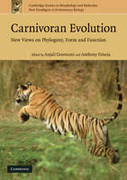
Carnivoran evolution: new views on phylogeny, form and function
Goswami, Anjali
Friscia, Anthony
Members of the mammalian clade Carnivora have invaded nearly every continent and ocean, evolving into bamboo-eating pandas, clam-eating walruses and of course, flesh-eating sabre-toothed cats. With this ecological, morphological and taxonomic diversity and a fossil record spanning over sixty million years, Carnivora has proven to be a model clade for addressing questions of broad evolutionary significance. This volume brings together top international scientists with contributions that focus on current advances in our understanding of carnivoran relationships, ecomorphology and macroevolutionary patterns. Topics range from the palaeoecology of the earliest fossil carnivorans to the influencesof competition and constraint on diversity and biogeographic distributions. Several studies address ecomorphological convergences among carnivorans and other mammals with morphometric and Finite Element analyses, while others consider how new molecular and palaeontological data have changed our understanding of carnivoran phylogeny. Combined, these studies also illustrate the diverse suite of approaches and questions in evolutionary biology and palaeontology. INDICE: 1. Introduction to carnivora Anjali Goswami; 2. Phylogeny of the carnivora and carnivoramorpha, and the use of the fossil record to enhance understanding of evolutionary transformations John J. Flynn, John A. Finarelli andMichelle Spaulding; 3. Phylogeny of the viverridae and 'viverrid-like' feliforms Geraldine Veron; 4. Molecular and morphological evidence for ailuridae anda review of its genera Michael Morlo and Stephane Peigne; 5. The influence ofcharacter correlations on phylogenetic analyses: a case study of the carnivoran cranium Anjali Goswami and P. David Polly; 6. What's the difference?: a multiphasic allometric analysis of fossil and living lions Matthew H. Benoit; 7. Evolution in carnivora: identifying a morphological bias Jill A. Holliday; 8. The biogeography of carnivore ecomorphology Lars Werdelin and Gina D. Wesley-Hunt; 9. Comparative ecomorphology and biogeography of herpestidae and viverridae (carnivora) in Africa and Asia Gina D. Wesley-Hunt, Reihaneh Dehghani and Lars Werdelin; 10. Ecomorphological analysis of carnivore guilds in the Eocene through Miocene of Laurasia Michael Morlo, Gregg F. Gunnell and Doris Nagel; 11. Ecomorphology of North American Eocene carnivores: evidence for competitionbetween carnivorans and creodonts Anthony R. Friscia and Blaire Van Valkenburgh; 12. Morphometric analysis of cranial morphology in pinnipeds (mammalia, carnivora): convergence, ecology, ontogeny, and dimorphism Katrina E. Jones and Anjali Goswami; 13. Tiptoeing through the trophics: geographic variation in carnivoran locomotor ecomorphology in relation to environment P. David Polly; 14. Interpreting sabretooth cat (carnivora; felidae; machairodontinae) postcranial morphology in light of scaling patterns in felids Margaret E. Lewis and Michael R. Lague; 15. Cranial mechanics of mammalian carnivores: recent advances using a finite element approach Stephen Wroe.
- ISBN: 978-0-521-73586-5
- Editorial: Cambridge University
- Encuadernacion: Rústica
- Páginas: 506
- Fecha Publicación: 29/07/2010
- Nº Volúmenes: 1
- Idioma: Inglés
